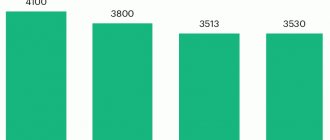What is it in simple words
Marginality is one of the main concepts in business, stock exchange and banking. It refers to the difference between the cost of production (the cost of manufacturing it) and the price paid by the buyer. It’s not for nothing that the word “margin” in translation means “difference” (margin).
Also, margin often means profit from each unit of production and profitability ratio. The latter helps determine the success of any enterprise.
Video: margin is in simple words:
Therefore, knowledge of the concept of “marginality” is necessary for successful business. After all, even setting a high price for a product does not guarantee high profits. To do this, you must also take into account the costs incurred. That is why it is necessary to be able to correctly calculate the margin. In simple terms, margin is what you received over and above your profit. In other words, this is net revenue.
It is important for a novice businessman to remember products with high margins. They have a high level of demand and are always in demand on the market, since, as a rule, they are represented by only one or several sellers. This allows the manufacturer to receive greater profits from their sale. The following products are considered high-margin:
- seasonal products, usually sold on certain dates;
- branded products.
Examples of goods with a high level of margin are: flowers, non-alcoholic products, hand-made goods, elite alcohol, expensive teas and coffee...
Failed business ideas
They learn from other people's mistakes. It’s also worth learning from other people’s failures in business:
- An attempt to increase profits by reducing the cost of production. For this purpose, cheaper ingredients are used, for example, for brewing beer. The result is a deterioration in taste, the appearance of sediment, a sharp drop in demand and a forever damaged reputation.
- Insufficient diagnostics at the development stage - this is especially true for medical devices and drugs. Thus, one company went bankrupt after releasing pacemakers on the market, which, as it later turned out, had a short circuit. Compensation for damage to health and moral damage quickly made the company bankrupt.
- Production of unjustifiably expensive products. Thus, Apple released its computer in a transparent case, turning it into a work of art, but without calculating the technical characteristics. The cases were covered with cracks despite the fact that the computer was prohibitively expensive.
Products with high margins
According to a survey of retailers, the highest-margin products are:
- Non-alcoholic products . This category of goods has the highest markup. Indeed, the production costs of these products are minimal, and prices are kept high. This is achieved mainly through a successful advertising campaign and promotion of a certain lifestyle, which effectively affects the target audience - teenagers and young adults. This primarily applies to carbonated drinks. However, simple drinking water is not far behind. The margin especially increases when it is sold at resorts. Baby water is the highest marginal product in this category.
- Flowers . The margin of this product also depends on the season. By certain dates (March 8, February 14), the price of these goods rises significantly.
- Handmade goods . Only the author of such a product has an idea of its actual cost. Due to its uniqueness, the price can rise significantly.
- Holiday symbols . Many buyers cannot do without certain attributes at a holiday. These include, for example, fancy hats, cake candles, balloons, cards, etc. The population strongly associates these goods with the holiday. The costs of their production are negligible and incomparable with the high prices for them in stores.
- Costume jewelry . This product is widely sought after because it does not cost as much as jewelry made from real gemstones. Since cheap non-natural materials are used to make jewelry, the cost of such products is relatively low.
It won’t hurt budding entrepreneurs to familiarize themselves with this list of high-margin products in order to correctly determine their niche in the market.
What high-margin products are profitable to sell?
There are original ideas that can be used to create a business with a good income, but let’s talk about popular options for high-margin business.
Sale of seasonal goods
Winter and summer products are more relevant at the height of the season or before it begins. For example, people often forget that their winter shoes are torn or they don’t have a swimsuit, so the peak of shopping occurs just before the start of the season.
When creating your own online store of seasonal goods, you need to take care of developing advertising so that a buyer looking for a barbecue or a recreational tent stumbles upon your offer. And the markup will no longer stop him from buying the necessary product.
Sale of fresh flowers
Flowers are a business with a high average bill, because the price of several roses or a beautifully decorated bouquet can exceed several thousand rubles.
The markup on such goods reaches large sizes, for example, in Holland one tulip costs only a ruble, but here they are sold for about 50-60 rubles per piece. So why not a profitable business? It’s very easy to fight competition – beautifully designed bouquets and a price a couple of rubles lower, that’s all. The markup reaches 500%, since the cost of one flower is scanty.
Sale of hand-made goods
One of the business options where there is room for imagination and markup. After all, when you make a product yourself, you know its cost, and then mark it up as you see fit.
Handmade products include:
- Knitted or sewn clothes.
- Manufacturing of furniture and interior items.
- Various decorations made of beads, ribbons, threads, colored glass.
- Soft toys, unique dolls.
- Making household items - pillows, pottery, blankets.
The cost of the finished product is very low, but you can mark it up to 200-300% from above, the main thing is to focus on competitors’ prices and their range. If you greatly inflate the price, everyone will admire the work, but they are unlikely to buy it.
Sale of alcoholic beverages
Elite alcohol and craft beer are quite popular on the market. Such products always remain in trend and can serve as a gift or a gesture of attention.
The main thing in this matter is to comply with all laws and open a legal business.
Sale of elite varieties of tea and coffee
A business with high margins that has long proven itself among the population and entrepreneurs. You can buy various types of green tea directly from China, then package it beautifully and sell 100 grams with a markup of up to 350-400%.
You can also arrange sales as additional income if you already have a business in coffee shops. This product will be relevant for those who like to drink aromatic drink.
Sale of goods “everything for the holiday”
At first glance, it seems that various decorations, cups, balls, caps and garlands cannot bring much income. But in reality, everything turns out to be completely different - holiday goods are quite popular on the market, very cheap to purchase, and the markup on them is simply cosmic.
Various beautiful balloons with inscriptions, funny postcards, funny posters are often sold with a markup reaching up to 1000%.
In addition, holidays always exist, and even in the most crisis times, clients are accustomed to celebrating birthdays and other events, which entails constant demand.
Also pay attention to the creation of additional services in the store - organizing events; such agencies are quite relevant in our time.
Sales of related products
When opening a regular or online store, think about selling additional products as necessary to the main one. For example, when selling phones, offer all kinds of accessories - cases, protective films and glasses, headphones.
If you decide to open a flower shop, bring greeting cards, hire a seller who can beautifully package and arrange bouquets.
In business
The concept of business margin is closely related to the concept of product margin. The latter is a broader term. It means the ability of a business to bring its owners net profit on invested capital per year. The indicator is measured as a percentage.
Let's give an example. Let’s say an entrepreneur invested 1 million rubles in a business. A year later, the net profit amounted to 200 thousand rubles. To calculate the business margin, or rate of return, we divide the net profit by the amount of invested funds. We'll get 20%.
Knowledge of this concept is necessary not so much for business founders as for investors. For a successful investment, it is advisable to evaluate not only the profitability of the business as a whole, but also of its individual projects. The most high-margin type of business, especially in Russia, is trade.
The most profitable business ideas in the service sector
Services, like goods, must either be in great demand or offered by few people. And it’s best if both the first and the second are present.
- Flocking surfaces
The process itself is not new, but services of this kind are rare in Russia. The point of the process is to give absolutely any surface a velvety feel, which is achieved by applying flock to it - small fibers of different colors and lengths.
You can flock a smartphone case, a computer mouse, internal parts of a car, a laptop lid and much more, turning an ordinary thing into an exclusive one.
Production process : using a flocker (a special device, costing about 20,000 rubles), flock is applied to any previously cleaned and degreased surface. The villi are firmly glued using an adhesive composition. They are affected by static electricity, so the fibers stick out like a hedgehog, providing a velvety effect.
Approximate costs : 20,000 for a flocator, 1000 rubles. per kilogram of flock at a consumption of 1 kg per 5 sq. meters. The best way to advertise on social networks is for free. To get into the swing of things, you can start by flocking inexpensive printed products - postcards, folders, etc.
Business profitability : flocking price starts from 50 rubles. for a plot of 10 by 10 cm for large orders. For small parts and items, the minimum cost is 200 rubles. a piece. Your main clients may be car owners who want to add exclusivity to the interior design of the car. The greatest return can come from original works with individual flock selection and color combinations. Approximate profit - from 50,000 rubles. per month if there are enough clients.
- Renting out real estate
The most successful business ideas of our time are, among other things, related to the real estate market. Reselling apartments and houses, renting them out, building housing - all this has excellent profitability if you do not act at random, but after a preliminary analysis. For example, in Istanbul, apartments become more expensive every year by at least 10 percent (in some areas of the city - by 18-20%). It is easy to calculate that the apartment will fully pay for itself in 5-10 years, and if you rent it out at this time, then in 2-3 years.
In Russia, the numbers are not so rosy, and yet renting out housing in a densely populated city brings a stable profit with a minimum of monthly costs.
The greatest demand is for “one-room apartments” located in the center or close to universities and colleges. Someone buys a three-ruble note and rents it out to several students at once, two people per room.
Approximate costs : will be individual for each city. You can decide on one of two options - invest money in an apartment at the construction stage and receive the property in a year or two with a discount of up to 50% from the price of the finished one, or buy a ready-made apartment and immediately start renting it out. In economic terms, the first option is more profitable, but it carries more risks.
Business profitability : let's say you bought an apartment for 1 million, and rent it out for 15,000 rubles. per month. The apartment will fully pay for itself in 5-7 years, after which you will be able to sell it for at least the same million (usually more).
In banking
The concept of margin is central to the banking business. In particular, determining the interest margin is particularly important. It represents the difference between interest received and interest paid. In other words, between the interest received from borrowers and the interest paid to lenders. Therefore, the bank needs to correctly set interest rates on loans and deposits in order to have a sufficiently high interest margin. Accordingly, if a bank lowers interest rates on loans, it will also lower the yield on deposits so that the interest margin does not decrease. And vice versa.
Calculation of gross and percentage form
Marginality can be gross or percentage. The gross indicator reflects the performance of the company. It is formed on the basis of labor costs and the provision of services. The gross value does not include funds for rent, staff salaries, and utility costs.
Gross indicator is the difference between profit and labor costs. Gross margin shows the level of profit taking into account cost. An organization is considered to be operating successfully if the gross value is 50-60%.
Experts distinguish between the concept of gross margin for Russia and in Western countries.
Formula for calculating gross margin in Russia:
Gross contribution margin = revenue – variable costs
This is the marginal profit that is used to calculate financial transactions. Marginal income does not reflect the state of the organization; it shows the costs of paying fixed costs and generating income.
Or gross margin = revenue – total cost
In Europe, the indicator is calculated in %.
Interest margin is the relationship between costs and income. The value shows the share of costs in relation to profits.
Rules for calculating margins in the video:
It is calculated like this:
Percentage margin = total cost / revenue
Or percentage contribution margin = variable costs / revenue
For Russia, margin is income, for Europe it is a percentage indicator of activity.
Why do you need to calculate these indicators?
Marginality is of interest to the following categories of businessmen:
- business owners;
- investors.
Investors need it, first of all, in order to determine which business is preferable to invest in in order to get greater returns. Before starting a new business, you should define a niche. For a business to be successful, it is necessary to choose the highest-margin areas of business. Therefore, the first thing a future business owner does is to calculate the marginality indicators of the business he is interested in in general and goods in particular.
What is margin
Margin in the understanding of the common man is profit
. More precisely, the difference between the cost of what you offer and its sales price.
Revenue from the sale of goods, work, services is the margin.
The margin can be:
- trading or market
- credit;
- banking and others.
The higher the margin, the higher the high-margin product.
That is why individual entrepreneurs (especially young ones, because they want fast and big ones) strive to find and quickly fill highly profitable niches.
How to calculate marginality: calculation formula
Marginality can be calculated in absolute and relative values.
In monetary terms
In absolute, or monetary terms, the sales margin is equal to the markup and is calculated using the following formula:
M = CT – C,
where M is marginality;
CT – price of the product;
C – cost.
Margin can also be calculated using the formula:
M = sales revenue – variable costs
In percentages
However, for greater information, it is recommended to use the formula for calculating marginality in percentage terms:
M = (CG – C) / CG x 100
Let's give a clear example of calculating the marginality of fictitious sales. To do this, we need profit and loss statement data. Data are given in thousand rubles.
| Index | Period | |
| 2017 | 2018 | |
| Sales | 190 000 | 200 000 |
| Cost of goods sold | 160 000 | 180 000 |
| Gross profit | 20 000 | 40 000 |
| Commercial expenses | 19 000 | 30 000 |
| Revenue from sales | 900 | 2 000 |
| Percentage to be paid | ||
| Other income | 40 | 900 |
| other expenses | -80 | -1 000 |
| Profit before tax | 850 | 1900 |
| Taxes | -100 | -500 |
| Income after tax | 700 | 1700 |
The data required for the calculation is highlighted in yellow.
It turns out that the sales margin for 2020 is 15.8% (190,000 – 160,000) / 190,000.
Marginality and profitability: what are the differences?
The main difference between profitability and marginality is that these concepts have different economic meanings. The margin, although expressed as a percentage, reflects the net profit of the entrepreneur.
The difference between marginality and profitability lies in the relativity of the second indicator. Fixed costs are not taken into account to calculate margin
, which are necessarily used to calculate profitability.
Products with a large markup, or high-margin products, are those items for which demand is usually quite high, even despite inflated prices. All sellers strive to sell just such products, as they significantly increase the company's profits. Let's consider which products have the highest profitability and which ones have the highest markup.
The difference between margin and markup
After studying the presented material, a mistaken opinion might have formed about the identity of the concepts “margin” and “markup”. Of course, these terms have many similarities, but they also have significant differences. Thus, margin is an indicator of income after deducting mandatory costs. And the markup represents the additional price of the product.
They also differ in calculation methods. Thus, the calculation of margin depends on the total profit of the company. And the calculation of the markup value depends on the original cost of the product.
Margin and markup are calculated using different formulas. To begin with, here is the formula for calculating margin:
Margin = (Selling price - Cost) / Selling price x 100
In turn, the markup formula is as follows:
Markup = (Sale price - Cost) / Cost x 100
Thus, they differ only in the denominator. Moreover, if you calculate the markup and margin in absolute terms, they will have the same meaning. They will differ only in relative indicators. In this case, the markup will exceed the margin.
Let's give a simple example. Let's say a certain product costs 10 rubles, its cost is 9 rubles. The markup and margin will be 10 - 9 = 1 (ruble). In relative terms, they will differ: the markup will be 1/9=11.11%, the margin will be 1/10=10%
Another difference between margin and markup is that margin can never be 100%. This is explained by the fact that the cost cannot be equal to zero. But maybe a markup.
Margin and markup are needed to track changes in the situation over time. At the same time, the markup and margin are directly proportional to each other: the higher the markup, the greater the margin. From this we can conclude that in order to get more profit, the markup should be raised.
Using markups and margins, you can track how things are changing over time. The higher the markup level, the higher the margin. It follows from this that in order to increase profits and develop the business, you need to increase the markup on the product.
Another concept that should be introduced in this topic is gross margin . It should not be confused with margin and markup. Gross margin is a percentage of total revenue after subtracting direct costs (those associated with producing products and providing services).
Gross margin itself does not in any way characterize the financial condition of a company. An indicator such as the gross margin ratio (GMR) will help us with this. With its help, you can track the dynamics of the company’s economic efficiency, as well as compare this indicator with competitors. The formula is presented as follows:
KVM = VM/VR,
where VM is gross margin;
VR – revenue from product sales.
This indicator is also necessary to calculate the break-even point and the strength of operating leverage.
How to calculate the margin of a marketing/advertising project
To understand how to calculate project margins in practice, look at this simplified algorithm:
Step 1 - man-hour cost
Determine the cost per hour of work for each employee. First, calculate your annual earnings.
For full-time employees, this will include:
- gross salary
- pension contributions
- insurance and bonuses
- other payments.
Then calculate the number of working hours per year: multiply 40 working hours per week by 52 weeks of the year and subtract days of paid vacation, sick leave and national holidays. Now divide the annual amount of wages for labor by the number of working hours.
Cost of man-hour = Annual salary / Number of working hours per year
Calculate the cost of freelancers in a similar way. It's even easier because they usually work on an hourly basis.
Knowing the cost of a man-hour and the time spent on a project, we will determine the direct costs of this project.
Step 2 - Overhead
To determine the net margin, you need to calculate not only direct costs, but also overhead costs for the year.
Overhead costs include all expected costs that cannot be attributed to a specific project:
- working hours that are not related to a specific project
- administrative staff salaries
- rent
- public utilities
- insurance
- transport
- payment for entertainment
- office equipment
- Software, hosting, tools.
Add up all the overhead costs for the year; they also need to be taken into account when calculating the project’s margin, along with direct labor costs.
Step 3 - Overhead per hour
First, calculate the sum of paid hours of all employees for the year - multiply the number of employees by working hours per year.
Now divide the annual overhead by the billable hours:
Overhead per hour = Amount of overhead / Amount of billable hours
Step 4 - Gross and Net Margin for Each Client
To calculate gross margin, subtract the cost of hours worked from the total value of contracts completed:
Gross Margin = Gross Sales - Sum of Hours Worked * Cost of Man Hour
To calculate net margin, you also need to take into account overhead costs.
Net Margin = Gross Sales - Sum of Hours Worked * (Cost of Man-Hour + + Overhead per Hour)
To calculate a project's margin percentage, divide the monetary margin by gross sales and multiply by 100.
In practice, the calculation algorithm is much more complicated: the agency employs specialists with different wages, projects can be long-term or one-time, some of the work can be transferred to a subcontractor
. But the principle of counting is correct.
If you are not happy with the result, you may be doing something wrong. Here are the typical mistakes of digital agencies that lead to a decrease in business margins.
Maybe you:
- you do the work for free: you perform client tasks that are not included in the agreed scope of the project. Why does this happen: it is always difficult to refuse, but it is not difficult to provide a small service at your own expense. But while working on a large project, such tasks can accumulate to a significant amount. If you deliberately do this to earn the client's loyalty, be sure to announce that you are giving him a gift. Otherwise, he will take free services for granted!
- do not take into account all the time spent on the project: you and your team members neglect detailed timing. Consider all time spent on the project, both paid and unpaid. If you work on an hourly basis and don't accurately track how much time and resources you spent on the project, you won't be able to bill correctly. If you work at a fixed rate, then time tracking is needed to understand how effectively you are using your time and resources.
- do not work on errors after the project is closed: you do not discuss the project with the team and do not look for ways to improve activities, which means you repeat the same mistakes over and over again. Organize an hour-long meeting after closing the project and, together with your team, answer just three questions: “what was done well?”, “what didn’t work?” and “what should we do differently next time?” Something like Scrum.
- underestimate the cost: you are too optimistic in matters of time and resources and are afraid to raise the price tag so as not to lose a client. Constantly improve your project cost calculations and check with your competitors. Record the cost of typical marketing operations in a journal and make changes on time.
- you lower prices during negotiations with a potential client because you are afraid of missing out on a deal, with the intention of compensating for this drawdown in the process. But it’s usually not possible to compensate - either the customer is not too happy with you anyway, or the budget was cut, or the scope of work was sharply reduced.
Indicator analysis
By studying marginality, they get a complete picture of the organization’s performance. It shows how profitable/unprofitable the enterprise is. Using the indicator, the following is determined and controlled:
- profitability of the work as a whole and of each project separately
- the impact of employee remuneration on the profitability of the enterprise
- the most profitable customers
- increase or decrease in profitability
- most expensive projects
- how much does each service cost?
Profitability analysis allows you to respond in a timely manner to a decrease in profitability and increase the cost of services. If the need arises, unprofitable projects are abandoned.
For an accurate picture, a quarterly figure is calculated. If the enterprise operates stably, annual payments are limited.
For the normal operation of any enterprise, calculation and analysis of margins is necessary at every stage. It allows you to respond in a timely manner to a decrease in profitability, form a development fund, and correctly set a premium for goods (services).
Top
Write your question in the form below
The most profitable types of small businesses in Russia
When assessing the most profitable small business in Russia, the rating can be presented as follows (the share in the total number of recognized profitable activities, the profitability of which, regardless of the season, is 100 percent or more):
Read also:
Business plan: how to open a nightclub from scratch
| Place in the ranking | Industry | Percentage share |
| 1. | Small wholesale bases | 0.15 |
| 2. | Shops (groceries and manufactured goods) | 0.11 |
| 3. | Market trading | 0.1 |
| 4. | Repair and construction | 0.09 |
| 5. | Advertising, including online, website promotion | 8.5% |
| 6. | Consulting, professional services (accounting, jurisprudence) | 7.5% |
| 7. | Educational services (tutoring, governesses, nannies) | 0.07 |
| 8. | Medicine (massage, nursing services, nursing activities) | 0.06 |
| 9. | Event organization, animation, floral design, photography | 0.05 |
| 10. | Domestic services to the population - studio, watch repair, etc. | 4.5% |
| 11. | Public catering | 4.5% |
| 12. | Vending business | 0.04 |
| 13. | Hotel business | 0.03 |
| 14. | Farming | 0.02 |
The remaining 3% covered other industries. Some of them, with high potential profitability, are distinguished by high requirements for initial investments in their organization. For example, specialized clinics, leasing property, drilling wells, oil and gas.
Others have not yet become widespread because the client market has not been formed or sufficiently prepared, and they can only develop in large metropolitan areas for now. These include private managers, financial consultants, and chiropractors.
Some of them will become promising and in demand over time, others will not become widespread and will not become profitable types of small businesses in any other regions.
Most profitable small business [sc:year]
The overwhelming number of professional analysts agree that the most profitable and profitable type of business is construction, consumption and catering.
The most promising features are repair, installation and construction work. Profitability within such a business can reach 100 percent of the cost.
- Beauty and health. Beauty services have always been an equally profitable area of business. Every person wants to be not just healthy, but also beautiful. Today, the business of providing beauty services is in demand and highly paid. People of all financial abilities and ages will always spend money to maintain their health and beauty. This is why massage parlors and hairdressers are so popular.
- Construction sector. As mentioned above, one of the most profitable types of business in Russia is construction and installation work. This is explained primarily by the growth of the real estate market and the coverage of a wide range of activities. One of the advantages of this type of business activity is the minimum financial threshold. For example, if there are not enough funds to open a construction company, then you can form a team of professionals and gradually expand the list of services it provides. If you have significant funds, you can safely build real estate.
- Trade in food products. No less popular and profitable is the satisfaction of primary human needs - nutrition. It is best to start trading in a residential area, in which there are no retail outlets that can have any significant competitive impact. If there are no large investment opportunities, you can open a small stall, gradually expanding the assortment and, as a result, sales volume. Having collected enough money, you can safely open a grocery store or a small restaurant. The most important thing in this business area is the correct selection of suppliers.
Women are trying more and more to realize themselves in entrepreneurial activity and they are doing well at it. Business ideas for women - proven ways to become successful. Where to start and which areas to choose?
Read about how to open your own cafe here. How to choose a location and what documents you need to have.
If you have experience working with children and you like it, you can open a private kindergarten. Iui https://businessmonster.ru/otkryitie-biznesa/biznes-planyi/kak-otkryit-chastnyiy-detskiy-sad-vyigodyi-i-preimushhestva-dlya-sobstvennika-vozmozhnyie-problemyi-i-podvodnyie-kamni.html detailed information about the nuances of business and how much you can earn.











